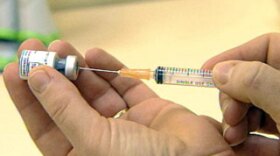Compared to many other cultures around the world, Americans place a high value on cleanliness. But with the coronavirus now declared a global pandemic, we’ve all become hygiene-obsessed.
As part of our Embodied series, host Anita Rao gets several points of view on hygiene — from the individual habits that go viral on social media to the institutional practices that shape our public health.
Mike Dimpfl, a lecturing fellow in Duke University’s Thompson Writing Program, discusses the front-line labor that enables hygienic public spaces. Dimpfl has written extensively on cleanliness practices and how they intersect with institutional power and everyday practices.Elahe Izadi, pop culture writer at The Washington Post, joins the conversation to reflect on popular culture and social media’s reaction to the coronavirus as well as the cultural roots of our personal cleanliness.
Finally, Kendra Madding Lampron, a health teacher at Central Park School for Children in Durham, discusses where we learn hygiene, who teaches it and how the curriculum has changed over time. And Skip Elsheimer, founder of A/V Geeks, shares some archival educational footage on hygiene and reflects on how gender norms around cleanliness — and public service announcements — have changed over time.
Interview Highlights:
Mike Dimpfl on the invisible labor that keeps our public spaces clean:
The way we are being taught to frame our approach to this is about: What is my individual disease risk, right? Like: Can I stock my own pantry? And those conversations, I think are, again, ignoring who is most likely to be exposed to the disease on one hand, and you know, how we kind of organize the work of even being clean or hygienic in ways that rely on a very invisible population of workers: housekeepers, janitors, nurses aides, people who work in laundries at hospital systems, for example. These are people who are on the front lines of exposure here who are stuck between earning wages on the one hand and supporting their families. And it's sort of a missing element of how we're considering what's going on.
I think we do live in a time where [cleanliness and hygiene] have kind of merged in a world increasingly coated in a thin layer of hand sanitizer. - Mike Dimpfl
Elahe Izadi on humor and the coronavirus:
We are kind of making light of something that is very serious, but humor can really provide this release valve for collective anxiety. And it is a tightrope to walk, because when you are making jokes out of something that is very serious, you run the risk of making fun directly of people suffering and almost sort of congratulating yourself for not having to suffer in the same way. But if you do the joke right, if you do the meme right, it can resonate with folks, and it can provide a release of anxiety and also a feeling that: I'm seen and my experience is shared as well.
Kendra Madding Lampron on destigmatizing conversations about menstrual hygiene:
So we start talking about puberty and menstrual hygiene in fourth grade, kind of before some of those things are ingrained in kids, and I think because we never separate by gender, boys end up feeling really comfortable asking questions about menstrual hygiene in class. And I show how to use a tampon and I show how to use a menstrual cup and I show how to use pads and I bring them in and I let them hold them and feel them. Both sexes and genders understand what they are. And I think that's a huge part of the destigmatization.
Keeping Neat and Clean (1956):
https://www.youtube.com/watch?v=rkJeTT0snJI Soapy the Germ Fighter (1951):https://www.youtube.com/watch?v=6g-Ani8gS4k&t=229s










